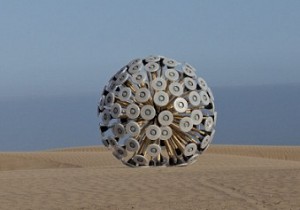Practices of High-Performance
BxD 1.2 Mine Kafon
Land mines and other explosive remnants of war are a significant problem around the world. According to a recent United Nations report, 3,678 people were casualties of such devices in 2014. 80% of those victims were civilians, and many of them were children.
Humanitarian efforts to address the threats posed by unexploded devices have often required the endangerment of humans or animals. When trained people or animals are dispatched to map or detonate mines, they face a serious risk of death or injury. Robots, too, can be damaged or destroyed when they are deployed to detonate mines. While losing technology is much better than losing lives, robots can be expensive, and their replacement can mean fewer funds going to other vital humanitarian programs.
What if better tools – more affordable and more rapidly deployed – existed for the safe detonation of unexploded devices? Such a question animates the work of Massoud Hassani. Hassani is an Afghan native who knows first-hand the worries of living in an area peppered with unexploded devices. Long after fleeing Afghanistan with his family, Hassani continues to focus his attention on the problems of living in a mine-marred land.
Hassani is the creator of the mine kafon. The original mine kafon, a wind-powered landmine detector, was developed as a student project. Both artful and practical, the mine kafon could be inexpensively constructed ($40 or $50) and placed in a mine-filled area to roll over mines and detonate them with its weight. The design would enable the mine kafon to keep rolling – and keep detonating mines – even after some of its appendages had been destroyed.
Like many first versions, the mine kafon had its limitations. It needed wind and a wide-open, level space in order to operate. Large explosions would prevent the mine kafon from continuing to roll after a detonation. And, if people were needed to recover a damaged mine kafon, its use carried the same safety risks as traditional approaches to mine clearing.
Nevertheless, the mine kafon captured the attention of organizations not usually invested in the issue of mine clearing. Organizations such as the Museum of Modern Art in New York City noticed the mine kafon and included it in its collection, for example. Consequently, Hassani has been able to increase global awareness about landmines and the humanitarian issues they present. He also has been able to garner funds to develop another generation of better solutions for mine clearing; the mine kafon drone.
Hassani has said that childhood memories of toys accidentally going into places where mines were present have inspired the design of the original mine kafon. His work – anchored in his personal experience from decades ago – stimulates questions about the connections between design thinking and lead users; about the roles of empathy and beneficence in the innovation process.
The history of our understanding of innovation begins in some ways with the research into lead users. Lead users tend to be individuals who use bricolage to innovate solutions to their own problems. Because these people have deep knowledge about their situated goals they are able to apply their technological competence to the rapid creation of useful innovations. Advocates of design thinking (and maker spaces) have borrowed from this framework to articulate an innovation process that can approximate the lead user’s situated understanding of a lived problem. In the design thinking framework, innovators are encouraged to cultivate empathy through sustained interaction with communities of interest; to develop a robust awareness of a problem as it is understood by someone who is experiencing it through observation and conversation. This empathetic awareness serves as a proxy for the lead user’s lived experience and helps a designer to create relevant innovations with high levels of acceptance.
Hassani, however, was not a classical lead user nor was he a typical innovator in the tradition of design thinking. He was neither enduring a present daily threat from landmines nor was he initially involving those who currently live in the presence of mines or work for the removal of mines. Instead, Hassani seems to have paired his lived experience from long ago with a stance of beneficence – a bioethical principle of active kindness.
Beneficence – acts to prevent or remove harm that are done for the benefit of others, sometimes without their participation – can be controversial. Even in urgent medical contexts, beneficent acts can present uncomfortable similarities with paternalistic acts that compromise the autonomy of others. And in innovation contexts, designers working without the sustained input of people who will feel the impact of an innovation may create misguided solutions of limited value.
Eventually Hassani did seek and embrace reactions to the mine kafon from the Dutch Army and other knowledgeable sources. Their feedback, in fact, influenced the next iteration of the mine kafon design. However, Hassani’s initial process does veer from the one typically associated with successful lead users or design thinkers.
Questions: If we look at the innovation process through the lens of beneficence rather than empathy what new insights are gained about the circumstances and practices that contribute to success? And might beneficence play a role in the creation of new technologies at the edges of science and technology; in areas of activity that the innovator cannot directly experience such as deep space travel or medical crises?
Share your stories about this topic with us. (Note: Submissions may not be posted in their entirety, and not all submissions will be posted.)
